A major complaint about Marvel’s Iron Fist season one (from me and others) was its weak-kneed portrayal of hand-to-hand combat and martial arts. This was a problem on several levels. One, the lead actor had no experience with martial arts or choreographed fighting. Two, the fight choreography was dismally bad. And three, that first season showed absolutely no understanding of kung fu in particular and martial arts in general.
The second season improved on some of these issues, but not quite enough of them. And in trying to fix one problem, they introduced more.
SPOILERS for Iron Fist season two, as well as the other MCU Netflix shows.
Getting the obvious out of the way, you gotta wonder what they were thinking (a) casting somebody with no martial arts experience to play the character who has been known in the comics since 1973 as “the Living Weapon,” the best martial artist in the Marvel Universe and (b) not getting a decent fight choreographer. It’s not like such options don’t exist. Hell, we see a whole bunch of people who are better at choreographed combat on Into the Badlands. Not all of them are trained, but they have superlative fight choreography—hell, they managed to make oval-shaped Nick Frost into a more convincing fighter than Scott Buck and the gang managed with Finn Jones in Iron Fist season one. It’s really kind of sad when you’ve got five characters with their own series, and the one with by far the worst fight choreography is the one about the martial artist.
This would be forgivable if Jones brought some kind of ineffable quality to the role, but he really doesn’t. He’s arguably the worst protagonist in Marvel’s pantheon since the debut of the Marvel Cinematic Universe a decade ago with Iron Man. (The only main character who comes close to being as awful is Anson Mount’s grimacing turn as Black Bolt in Inhumans.)
It’s not entirely his fault, of course, because of that third issue.
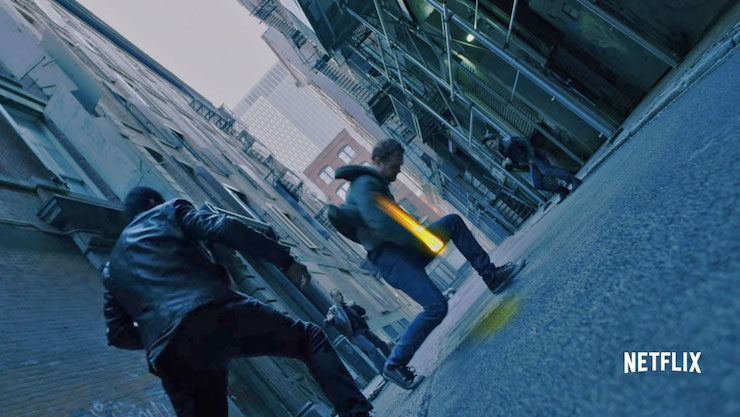
K’un-Lun, in both the comics and the TV show, is a place of pure martial artistry. The people of K’un-Lun are trained in combat from the moment they can walk (if not sooner). Martial arts—and in the TV series, they specify that it’s kung fu they’re training in—is a way of life there in a manner that is purer and more focused than it would be outside K’un-Lun’s walls, as the compromises of being part of the greater world don’t exist there. It’s a city enshrouded in dimensional mists that only intersect with our world once every fifteen years (ten years in the comics, but whatever).
The thing is, someone raised in that world should be the ideal martial artist. One who is focused and serene. One who only uses violence as a last resort, and who tries to minimize the damage done to one’s opponent. One who knows that once a fight has started, it has already been lost.
Of course, not every student is the same. Some take to the lessons better than others. But the ones who don’t take to it particularly well don’t ascend to the highest calling in the city, to wit, to become the Iron Fist.
Danny Rand is supposed to be the finest fighter in all K’un-Lun. He is supposed to have absorbed the lessons of kung fu, of martial arts, of being the Living Weapon better than anyone. He is supposed to be able to defeat any opponent, which is why he was given the honor of fighting Shao Lao the Undying to become the Immortal Iron Fist.
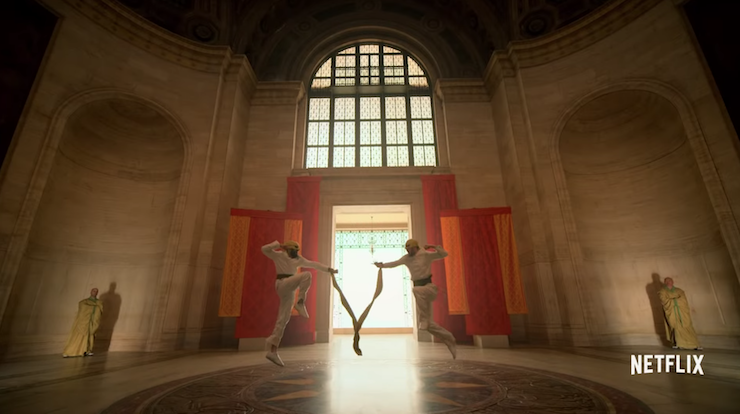
The one thing he should never, ever, ever be portrayed as is a whiny entitled twerp. And it’s not like this is arcane knowledge that only a martial artist would understand, because all Buck and his team of writers had to do to see what a good portrayal of someone from such a city trying to survive in modern New York would be is to read the comic books their TV show is based on.
Upon taking over from Buck, one of the things M. Raven Metzner did was address these problems. Jones is what he is at this point—his ability to do choreographed fighting is better in season two of Iron Fist than it was in The Defenders season one, which in turn was better than it was in Iron Fist season one, so there’s that. But “better” isn’t “good.” He’s still the third-best martial artist in the opening credits, behind Jessica Henwick—who learned wushu in preparation for her role in Spirit Warriors—and Sacha Dhawan—a trained dancer (the Venn diagram of choreographed hand-to-hand combat and a dance has significant overlap). Season two conveniently filmed during winter in New York City, so they didn’t even need to contrive an excuse for Rand to go out on patrol in Chinatown wearing a hoodie that conveniently obscured his face so the stunt double could be swapped in.
In addition, the position of fight choreography was upgraded, as Clayton Barber was brought over from Black Panther to handle the fight scenes, and the improvement is noticeable. Of course, it’s more noticeable when someone other than Jones is involved, but you do what you can. To be fair, one of the best scenes is Davos and Rand’s fight in K’un-Lun for the right to go for the iron fist. (The best is Colleen Wing and Misty Knight’s fight against the Crane Sisters.)
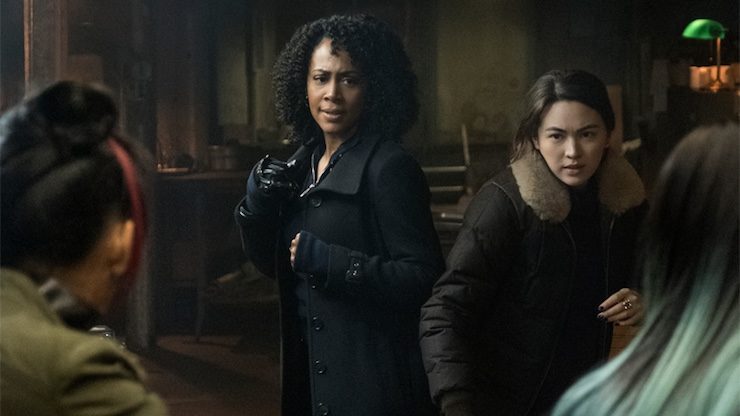
The major change, though, is seen when Rand details the feelings he has inside him, the heart of the dragon that powers the iron fist that pushes at the back of his mind, urging him toward chaos.
Now, we have a reason why someone who was raised in a society where kung fu is a lifestyle has been acting like such a douchenozzle. It’s the iron fist that fights against the serenity of martial arts. To emphasize the point, Rand is much more calm and centered after he loses the fist to Davos, while Davos—already unhinged by the loss of K’un-Lun—starts to crumble under the weight of the crazy.
Davos was actually a reasonable person in season one—pissed off, certainly, though that was justified by his own lights. But he’s also suffered trauma of his own, losing the iron fist, losing his best friend, and losing his home—and also his purpose. He thinks he deserves the iron fist, and it’s telling that one of the two things he does once he obtains it is try to make his own little K’un-Lun, as that’s all he knows. So he recruits a bunch of kids and starts training them. Though we only see the violence, we don’t see the philosophy, the wisdom, the serenity, the focus—we just see punching and kicking, which is not all there is to martial arts. We can forgive this to some degree, as Davos is broken even before he gets the iron fist, and after he achieves it, he goes seriously all binky-bonkers (particularly evidenced by his murder of the innocent restaurant owner).
This is handy as a retcon, but it doesn’t really make sense.
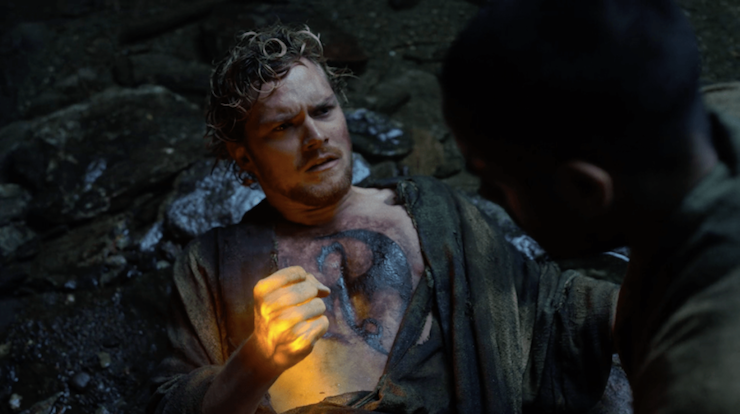
For starters, dragons in Asian myths are benevolent and powerful—it’s European dragon legends that talk of fire and destruction. In addition, while there are martial arts, and martial arts teachers, out there that are chaotic and violent and mostly in it for the opportunity to be a badass fighter, the vast majority of Asian martial arts in particular are geared toward focus, toward being centered, toward serenity. The purity of the movements of forms, being able to lose yourself in technique, the boiling away of frustrations and irrelevancies through the effort of accomplishing those techniques, and most of all the awareness of your own self (both mentally and physically) that you must have in order to master the styles. One of the best ways for me to deal with stress and frustration is to go to the dojo and sweat it out, as it were. In particular I’ve found that kata—prearranged forms—are very good for clearing my mind.
And I only do karate a couple three times a week or so, I didn’t grow up with it from the age of ten with nothing else significant in my life. Rand had no other distractions growing up. Everything was geared toward living the life of a master martial artist, an ascetic, aesthetic lifestyle that would result in someone who had achieved serenity.
But the Danny Rand we see on Netflix has nothing resembling serenity, and he spends season two seeking it out. (This puts him in company with the rest of the cast, as Wing, Knight, and both Meachams are searching for that same serenity in the wake of trauma.) And I gotta ask, why?

If it is the iron fist, then that raises another question: why would a city dedicated to the mastery of kung fu have as its highest aspiration be to become the Immortal Iron Fist, if the fist makes you crazy? If it negates all the training you went through to get it—worse, it negates the very philosophy under which your isolated city is supposed to be living under—why is it so aspirational? And also, if you need a protector for your city full of martial artists who’ve been trained since birth, why not use all the martial artists who’ve been trained since birth instead of just one dude with a glowy fist? Especially if that one dude is going to become unstable and twerpy when he gets the fist?
Some of these questions could be answered if we actually spent any significant time in K’un-Lun. (Just as a for-instance, maybe the dragon needs to be tamed, and the winner of the contest has to make the sacrifice of losing their focus and serenity in order to keep the dragon tamped down. Though, again, that really only tracks with European dragon legends, not Asian ones, but it’s a thought.) The first season showed us virtually nothing of the ancient city, and while the second season did better in that regard, it was mostly for the purposes of illuminating Davos’s character. As it is now, it serves only to put a band-aid on a bullet wound, and is about as effective. It answers one question, but raises several more. It’s maddening, because K’un-Lun is such an important part of Rand’s backstory (his first appearance in Marvel Premiere #15 took place entirely in K’un-Lun), and its lack has been a continued source of frustration.
Not that I blame Metzner for trying to fix it. We’re stuck with Douchenozzle Danny as Iron Fist (or, at least, as Danny Rand, since the fist hops from him to Davos to Wing), so he’s just trying to make the best of it. And there are actually story possibilities to be mined from the questions I’ve been asking here. Maybe season three will handle it…
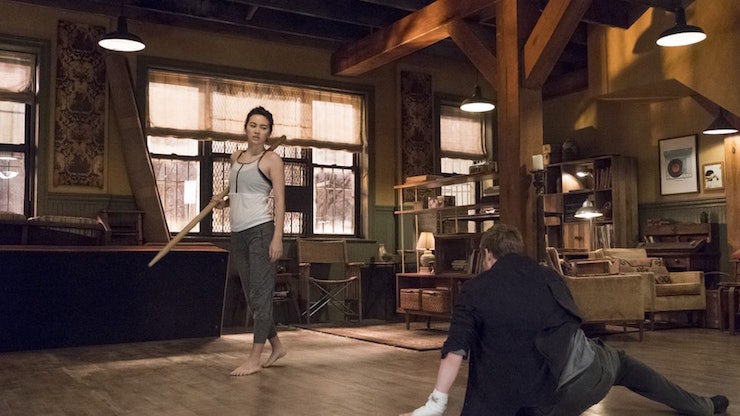
I want to end on a more positive note, so I will mention that one aspect that does ring right is the approach to teaching. The highest aspiration of a person who trains in the martial arts is to become a teacher—even styles that focus on fighting tend to have teaching as the ultimate aspiration, as the aging process tends to eventually erode one’s fighting skills. We see that with both Davos and Wing. In the former’s case, becoming a teacher is as important to him as doing Rand’s job as Iron Fist better than him. Training, passing on the traditions—those lessons are still critical.
As for Wing, her journey is nastier, as the whole notion of teaching has been tainted for her. When we first saw her, she ran a dojo, but it was a Hand front. Bakuto corrupted the teaching process for her by making it a method of recruiting soldiers. With Bakuto dead and the Hand destroyed, she has found she can no longer teach in good conscience. But not permanently: for one thing, we know from Luke Cage season two that she worked with Knight on getting her groove back after losing her arm. Here, she has to be convinced by Rand to re-train him how to fight without the iron fist (which is another example of how corrupting the iron fist must be, if he needs that much re-training after losing it, given the fifteen years of training that came before he faced Shao Lao). It takes a lot to get her to take up that mantle again, and ultimately it proves to be her salvation. Bakuto’s destruction of teaching has been replaced with a better, more beneficial experience. She can be the teacher she always should have been.
It’s frustrating that the best use of Asian philosophy and understanding of martial arts with regard to the Rand character came, not from any of the three series Finn Jones starred in, but in the one in which he was a special guest star: “The Main Ingredient,” the tenth episode of Luke Cage’s sophomore season. We need more of that Iron Fist, and less of the whiny twerp.
At the very least, Metzner was able to make a silk purse—or, at the very least, a nice linen purse—out of the sow’s ear that was season one of Iron Fist. We’ll see if whoever show-runs season three will take cues from that episode as well as all the work that was done in season two. It’s not there yet, but progress has been made.
Keith R.A. DeCandido is a third-degree black belt in karate. He trains regularly, and also teaches several classes a week to kids, including a couple of afterschool programs here in New York City. He’s been writing about pop culture for Tor.com since 2011. He is currently running a Kickstarter for a short story set in the same universe as his Dragon Precinct fantasy series.










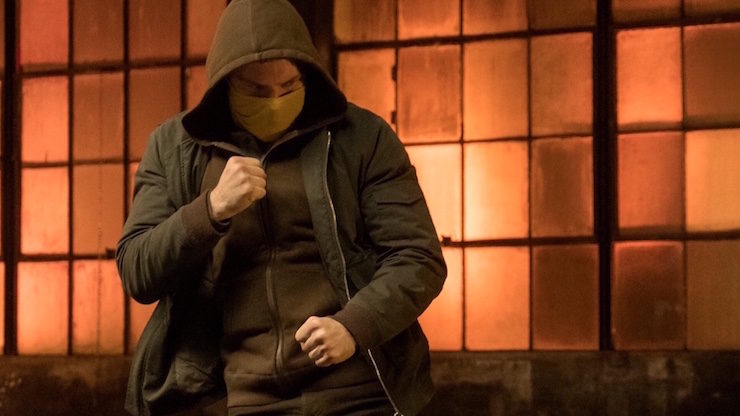
The K’un Lun masters we saw in season 2 did not seem like they were concerned with teaching serenity. They only seemed interested in creating a living weapon to destroy the Hand, and the process for doing so seemed both physically and emotionally abusive. I think we were supposed to get the sense that K’un Lun had become corrupt, that Danny was better off when he stopped letting himself be defined by its ideals and expectations, whereas Davos was doomed because he couldn’t transcend the same. (Although that somewhat comes off as just another variant of Orientalist cliches — rather than the white savior being better at Asian stuff than the Asians are, it’s the version where the white hero has to reject Asian values in order to become a better person.)
As for the benevolence of dragons vs. the corruption their power brings… In Diane Duane’s fantasy novels, there’s a phrase that sometimes comes up: “good but not safe.” Meaning that some magical entities are intrinsically benevolent, but so vastly powerful compared to humans that humans risk destruction by getting too close to the flame or just getting in their way. There’s no malice involved, merely a fundamental difference of scale, with humans simply being too fragile to cope with the entity’s power. This idea does come up in Asian culture too, specifically kaiju films, where even heroic kaiju like Mothra or Gamera can cause enormous collateral damage to human life in the course of battling a threat to the Earth, not because they bear humanity any malice but simply because we didn’t get out of the way in time.
So maybe the power of Shao Lao is intrinsically good, but if a human is too weak-willed to contain or control it, it runs out of their control and corrupts them.
You may actually have suggested this, but I’m not sure. It seems to me that one explanation for K’un L’un is that it knows the corrupting force of Shao Lao and therefore needs the Iron Fist to reach the peak of serenity and self-control in order to be able to handle the role.
Not that we actually see this with Danny Rand in S1 or even S2…
Great article Keith. I’m not anything resembling an expert at martial arts, but even I know from popular culture that the point of any martial arts training is first-and-foremost to avoid the conflict. Be able to walk away. If walking away is taken away as an option, then self defense is necessary.
I really think the problem I had with this season is the lack of continuity from Luke Cage Season 2. We know from Misty’s comments that Luke Cage Season 2 takes place before the events of Iron Fist Season 2. So why was Danny all “at peace” and able to help Luke find balance when he himself is so conflicted? We can’t blame the Fist (or the Heart of the Dragon or whatever) – Danny has had that for a long while now. I feel like the showrunners for LC2 and IF2 did not compare notes.
The only explanation that works at all for me is that Danny knows how he SHOULD be – balanced, etc., and is able to spout it all to Luke. And he’s able to relax and give the appearance of calm and balance when he’s helping Luke because it isn’t specifically his problem (he’s not emotionally invested like he is in Chinatown).
But it’s still a niggling vexation. As you mention – we need more of calm Danny Rand as he was in LC and less of whiny twerp Danny Rand from his own show.
Christopher: These are all good theories, but your multiple uses of words like “seemed” and “maybe” point up the problem — we don’t know because the stories aren’t actually telling us anything about K’un L’un. It’s maddening.
—Keith R.A. DeCandido
@3/Kalvin: I don’t see a conflict with Luke Cage, because in IF season 2, Danny starts out thinking he’s got everything mastered and figured out, and only gradually comes to realize that he’s got an addiction to the power and the fighting. Sure, we learn he had that secret room where he beat up on doors all night, but he himself said that he initially thought of it as just a form of training, and only belatedly realized that it was a symptom of his craving for the power. So before season 2, at the time of his LC appearance, he didn’t know he had a problem. He believed he’d found peace and balance, and he hadn’t yet figured out that it wasn’t really so.
@1 Christopher
Eastern mythology puts dragons as serene and benevolent. Sometimes hard to understand, but they are not destructive. Western mythology holds the idea that dragons are destructive. Which is what Keith was talking about (I did a – and I limited it – 35 page college paper on this dichotomy 30 years ago, combing through every mythology that held dragons that I could find. It’s more than amusing that middle eastern mythology holds both types of dragons. )
@6/Wrenn: Yes, I’m quite familiar with Asian mythology, thank you. My whole point was that even a benevolent divine power can potentially become harmful in human hands, because humans could be too weak to control it. As I said, “good but not safe.” Think of dragons as adults and humans as children. My suggestion is that dragons are powerful enough and mature enough to use their power benevolently, but humans are smaller and weaker and are thus more likely to harm themselves or others if they attempt to use that same power.
After all, power is intrinsically neutral. The good or evil is in how it’s used. Fire can create when used with skill and responsibility or destroy when used with carelessness or malice.
You’d have thought after the lambasting from S1, Finn Jones would have done some intensive MA training. It sounds like he didn’t. <sigh>.
I guess a good baseline would be Kieth Caradine. Didn’t he have no martial art experience before Kung Fu?
And I thought Eastern mythology had dragons embody a range of aspects? I thought they could be the East Wind, to send both gentle rain and be the source of storms, or the manifestation of a river (both benevolent and when it floods)?
At least Keith Carradine had the serenity of a martial artist.
@8/WillMayBeWise: To all accounts, Jones did train heavily with the new stunt coordinator, just as much as everyone else in the production. The problem, it seems, is that he’s just not as intrinsically talented at martial arts or stunt fighting as many of the other actors.
David Carradine was the star of Kung Fu, although his younger brother Keith did play his younger self in a couple of first-season flashbacks.
As for Asian spirituality, it doesn’t tend to use the same concepts of “good” and “evil” that we have in the West. Divine or supernatural entities are neither invariably benevolent or invariably malicious; rather, they can be either depending on the circumstances. Often, they will bless and reward those who treat them with respect and reverence but bring mischief or ruin to those who fail to show proper courtesy. Or sometimes it just depends on whether you catch them in a good mood. You can see this ambiguity in Hayao Miyazaki’s films like Princess Mononoke and Spirited Away.
The concept of Dragon is only a European thing. When the traders first came to China they associated the statues with their own history instead of accepting these “unexplained” figures from the Chinese viewpoint. They are called Long and share no resemblance to a Dragon. Lost in translation
Just curious but does anyone recognize the martial arts styles that Danny, Davos and Colleen use in the series?
When Colleen trains Danny, it wasn’t so he could learn to fight without the fist. At least, that’s now how it seemed to me. I thought he asked her to train him because of his injuries. He didn’t have time to fully heal, and he was wearing that high tech leg brace. The training was to help him fight around those injuries. And to generally refocus himself, since, as is the point of the article, he wasn’t in the right head space. But I didn’t think It was about not having the fist.
blairb: Fair point.
—Keith R.A. DeC
@6 That’s intriguing re Middle Eastern dragons – I’ve not come across benevolent ones from that part of the world, I’d love to know more.
@10/ChristopherLBennett – we’ll, Frak, it seems like it sucks to be Finn Jones if he put the work in and still isn’t in the same league as his Co-stars.
I wonder why I wrote Keith instead of David, if he was the minor (in both senses) actor. Odd. Anyhow, I think my point still stands. As I understand it, David Carradine has no Martial Arts experience (never mind Kung Fu) before he won the role, yet still seems convincing as an expert, to the point at which he’s typecast. Although I’m ready to be corrected on this.
As to the eastern spirits westerners call dragons not conforming to a western moral dichotomy, I thought that was what I was saying when I discribed them as being responsible for both beneficial and detrimental events.
@16/WillMayBeWise: Wikipedia says that David Carradine drew on his skills as a dancer, as well as his knowledge of boxing and swordfighting, to handle the stunt sequences in Kung Fu — and of course the show had a fight consultant who taught him the moves. As Keith pointed out in the article, dancing ability can help a lot with stunt fighting — which is why Summer Glau was so good at it in Firefly, Serenity, and elsewhere. (I remember behind-the-scenes commentary about Serenity talking about how amazing Glau was at being able to perform every step of an intricate fight scene over and over again with perfect consistency.)
As for the question of Eastern mythology and morality, yes, I was answering your question in the affirmative and giving some more detail about it.
@17/ChristopherLBennett- so, while not having experience with eastern martial arts, he already had experience of some western styles. Plus dancing. So maybe not a good baseline, then. I’m guessing Finn Jones didn’t have any of that grounding. I known everyone can have an off-day, but (like KRAD), I really questioning his casting…
In Earth-616 there was an actual reason for the existence of The Immortal Iron Fist as a guardian of K’un-L’un and, from the way the second season ends, I’m pretty sure the third season will adapt the Immortal Weapons arc from Matt Fraction’s run (Collected as The Immortal Iron Fist: The Complete Collection v.1) which is where the role of the guardian comes to play.
So what I’m saying is that the 3rd season might be better, considering it gets made.
This season and the new season of Luke Cage, and Jessica Jones were hard to get through. I only kept going because I had put in the time already on the whole Netflix lineup. I’m not sure what is happening in the background but everything from the writing to the acting to the directing is way worse than their first seasons. Cringe worthy at times. Maybe it’s the sophomore slump (is that the correct term)? Honestly if the new season of Daredevil is as consistently bad, I’m going to give up on all of them. There are too many great shows out there to waste on this.
So, I’ll take my small share of the blame for this series being cancelled, since I complained about it. I was excited, though, by Colleen becoming the new Iron Fist and looking forward to what they’d do with that.
Maybe now we’ll get that Daughters of the Dragon series. Certainly, Misty will continue to be part of LC and perhaps Colleen can be folded into the other series as well.